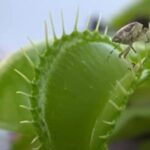As an Amazon Associate, this site earns commissions from qualifying purchases. For more details, click here.
Did your Venus flytrap suddenly develop a bad smell? Or have you noticed the odor increase slowly over several days or weeks? This is hard to ignore for obvious reasons, but fortunately there are easy ways to figure out why this is happening, and what you can do to fix it.
Venus flytraps do not produce scents that humans can detect. If there is a foul odor coming from the plant, it is due to root rot, bacterial or fungal infection or a decayed insect caught in one of its traps.
Why Does My Venus Flytrap Stink?
Venus flytraps do not generate smells that we can sense. Their traps produce nectar which has a scent, but only insects can detect this. If your plant has a foul smell there are many possible reasons. We will take a look at the most likely culprits and how to remove them.
Rotting Bug Inside the Trap
A decomposing bug caught in one of its traps is the most likely reason for the bad smell. There are two ways this could happen: the prey is too large or some parts are inedible and the plant does not eat it. Over time it starts to decay.
Venus flytraps release enzymes to dissolve as much of its prey as possible. Some insects like cockroaches and beetles possess a hard shell which these enzymes cannot break down.
These inedible parts are simply left over. The plant digests the soft tissues which can take up to two weeks. Afterwards the trap opens to reveal the decayed remains of the bug. If a closed trap smells bad, it probably caught a bug. The plant ate most of it except for the exoskeleton.
Another possibility is the trap tried to eat something too large. Imagine one of the traps catching a large wasp. It cannot get out, but parts of it are sticking out of the trap since it is too big.
The plant will consume only those parts inside the trap. Once digested the leftover will rot and spread to the trap, causing it to blacken and decay as well.
Solution
Remove the decaying trap and the dead insect, and the smell should disappear. Do not touch the trap with your bare hands. Wear gloves and use a pair of Fiskars Pruning Shears to trim the rotting trap, careful not to cut healthy leaves.
Repeat if you smell any foul odor from the other traps. A dead worm rotting inside a trap is going to smell really bad. If your Venus flytrap is outdoors, the rain will wash away the carcass and smell soon enough. If the plant is indoors, you have to remove the worm and find out how it got there in the first place.
Decaying Roots
You checked the traps but there are no bugs to be found. In this case we have to consider the possibility of root rot.
Venus flytrap root rot is caused by too much water or bacterial or fungal infection. Root rot can kill the plant so it needs to be addressed quickly.
Unless you dig up the plant you will not be able to see if the root is decomposing. But there are other symptoms such as a rotten smell and a large number of black leaves.
If you were able to rule out the possibility of a rotting trap or insect, you have to consider this especially if your plant looks like it is dying.
Venus flytraps need a lot of water. But too much of it can cause rotting so you have to use just the right amount. Knowing how much water to use will be essential to grow Venus flytraps or any plant for that matter.
Solution
Dig the soil and examine its roots. Rotting roots are mushy with a foul odor, and the bulb will be brown or black instead of white.
Get your pruning shears out and trim off the rotting parts. Repot the plant with new soil, preferably Natural Sphagnum Peat Moss, and make sure it receives several hours of light, water and nutrients. You have to wait a few weeks to see if the plant will survive.
If the smell disappears there is a good chance your Venus flytrap will survive. Not all plants will live though, so prevention is the best step you can take.
For more about root rot and how to prevent it, learn as much as you can about the variant you bought. Infection is a serious problem so you need to remedy this as efficiently as possible.
Root rot is fatal for a lot of Venus flytraps, but it can be prevented with proper care. Again, preventive step is the key because by the time the odor hits, the rot may have already spread around the plant.
Bacterial Infection in the Soil
Bacteria produces enzymes in the soil, which in turn generates phosphorus. This is good for plants in general but not for Venus flytraps because they can only grow in nutrition deprived soil.
Temperature, plants clustered together or humidity makes the soil vulnerable to bacteria and mold. Once infection sets in it can quickly spread throughout the plant. You can tell if there is infection because the soil has a rotten smell.
Solution
Remove your Venus flytrap from the pot and prepare a new soil mix. The best options are:
- 1 part perlite and 1 part peat moss
- 2 parts sphagnum moss 1 part silica sand
- 2 parts sphagnum moss 1 part perlite
- 2 parts peat moss and 1 part silica sand or perlite
Once the soil is ready, plant your Venus flytrap in a new pot. The container should be at least 4-5 inches deep. Set the pot outside so the plant can receive sunlight. Indirect sunlight for 12 hours a day is ideal.
If it is winter or your area just does not get a lot of light, use artificial light. Sunlight is still the best option though especially for Venus flytraps that have been exposed to root rot or soil infection.
How to Prevent Venus Flytraps From Smelling Bad
While there are many possible reasons for Venus flytraps to stink, preventive measures are possible. The following are some of the steps you can take to keep your plants from stinking.
Do Not Overfeed
Indoor Venus flytraps eat 3-5 insects a month on average. Only one trap needs to eat and that will be enough. If you are feeding dead bugs, serve them in small amounts so nothing sticks out of the trap. This reduces the risk of plant and insect rot.
This is easy to overdo because many get worried about the plant not getting enough nutrients. It is true that Venus flytraps need nutrients to be stronger. But too much eating forces the plant to use up its resources. If there is too much energy being used and not enough energy to replenish it, the plant will suffer.
Do Not Overwater
Venus flytraps need 1-2 watering a day during hot, dry periods. For winter, once very two weeks will suffice. Or you can just fill a tray with an inch of water and put the Venus flytrap pot there. When the water dries up, add more.
The tray method can be used anytime except when the plant is dormant. During winter, limit watering to the frequency given above. This will prevent overwatering and root rot.
The best option is distilled water for Venus flytraps. Tap water caries the risk of mineral deposits which could trigger an infection.
Proper Spacing
If you have several Venus flytraps, space them a few inches apart. Bacteria and fungi often grow around clustered plants, so keep them at a distance. By keeping your Venus flytraps separate, you will be able to protect the healthy plants in case one of them gets infected.
You should also trim the flowering stalk if you do not want it to bloom. Flowering takes a lot out of Venus flytraps and makes them vulnerable to infection.
Trimming the leaves and dead traps makes them easier to manage. Do not worry as the plant will grow new traps as long as it is healthy.
Conclusion
Anyone who has dealt with foul smelling Venus flytraps know how bad it can be. Hopefully the information in this guide was able to help so you can find out the cause and how to remedy it.

My fascination with carnivorous plants began many, many years ago with Venus Fly Traps. Now I am more than happy to impart what I know with other enthusiasts and those who are curious about meat eating plants.



